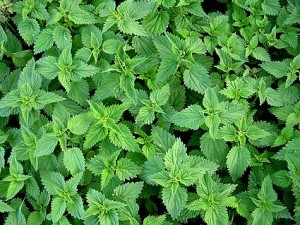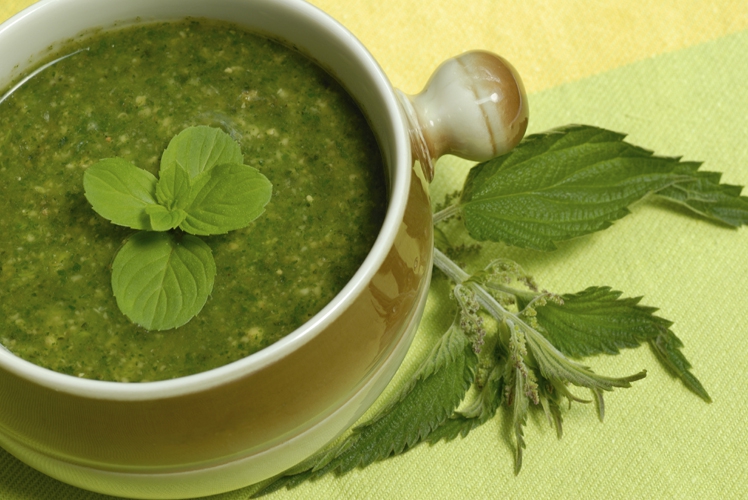I ate this. Yes I did.
The Nettle plant (Urtica Dioica) really isn’t anyone’s friend in the wild form. This plant is called “Stinging Nettle” because of the needle like hairs on the leaves that inject a mixture of histamine and formic acid when touched or brushed against. Nina my employee from Republic of Georgia said, “This is a childhood nightmare to get caught up with stinging nettle.” The plant ranks right up there with poison ivy for its effect on the unsuspecting hiker—a single touch can bring on an immediate, painful sting. Ironically a strange fact is that the juice of the nettle proves an antidote for its own sting within it’s leaves, and being applied will afford instant relief.
 The Latin root of Urtica is uro, meaning “I burn,” indicative of the small stings caused by the little hairs on the leaves of this plant that burn when contact is made with the skin.
The Latin root of Urtica is uro, meaning “I burn,” indicative of the small stings caused by the little hairs on the leaves of this plant that burn when contact is made with the skin.
Once cooked, the nettle’s stinging properties are neutralized. So it really isn’t for the brave of mouth. 🙂
Urzici (the dish name in Romanian) is traditionally cooked in the springtime and marks the advent of the season. It is one of the wild plants still gathered each spring in rural regions of countries like Romania as a “spring tonic” and pot-herb. It makes a healthy and very nutritious vegetable, which is cleansing and easy to digest. An old country remedy for chronic rheumatism and arthritis is “Urtication” or flogging with nettles. Ouch! Some folks even keep a nettle plant growing on a sunny windowsill, so that the healing stings might be applied throughout the winter.
Nettle was found growing wild at Simona’s parent’s home and Sandu, her father, brought me the examples to show me what plant that was the traditional before and after Easter plant that his wife always made. I was even able to snag a Romanian recipe for Stinging Nettle I believe this is the exact recipe I ate! Yum!
Now understand that in the past I’ve probably been one of the most picky eaters on the face of the earth. All my family can vouch for this. But I am brave when I travel, I love the culinary adventure. I tried urzici for the first time in Romania. What is urzici? Stinging Nettle? Of course! Why? Well it is traditional! I need to do this to teach my daughters. I need to do this to become a part of the culture. I needed to do this because I had such hospitable hosts.
Before big important holidays like Christmas and Easter or others, Romanians have a traditional fasting period, which means no animal products are allowed on the table. That means for some well-determined days they can purify their body, as fasting periods are not for eating fat, not for eating eggs nor other type of animal products. Sometimes, on particular Sundays of the fasting periods, which are determined and written down in the orthodox calendar, Romanians are allowed to eat fish. It is during these fasting periods that urzici is eaten.
What the fasting period does is prepare the body for the fat-rich and delicious food, which is cooked in every Romanian kitchen for Easter. Women and men start cooking the food days before the holiday, and pork is the basic element for the traditional food. There are all sorts of products made of pork, traditional sausages and others. No part of the pig remains untransformed. The Romanian recipes are special.
Urzici tastes a lot like spinach (only milder and nuttier taste) and is served with lots of fresh garlic and mămăligă (polenta).
Nettles have a nutritional profile unique to other greens. The spring shoots especially, but also the dried tea, are a powerful detoxification agent, and they are also thought to stimulate the immune system. Because spring, when young nettles are available, is an ideal time to detox, eating fresh nettles is great for the body. And (as described above) they can be very tasty!
Yes I ate it, pronounced it good and would eat it again. It can be used in place of spinach in any dish. I can only imagine Nettle in pesto, pastas, quiche, mixed with cheese and garlic! YUM!
 In fact, after I got home I made a little trip to the health food store and can proudly say I have Nettle Leaf on board. Ha! I’ve not encountered it growing in the Texas Panhandle. I’m not sure if it grows in other parts of Texas though. I think it may need wetter conditions than here.
In fact, after I got home I made a little trip to the health food store and can proudly say I have Nettle Leaf on board. Ha! I’ve not encountered it growing in the Texas Panhandle. I’m not sure if it grows in other parts of Texas though. I think it may need wetter conditions than here.
What about this Stinging Nettle?
Stinging Nettle has a long history of use. The tough fibers from the plant stem have been used to make cloth, and cooked Nettle leaves were eaten as vegetables. In historical terms, it seems that nettle (Urtica Dioica) has been used since prehistoric times. In Denmark, a tissue of this plant was found in a tomb dating from the Bronze Age. There is evidence that in the Neolithic era, the nettle’s stem has been used to make strings. It is also a known fact that Caesar’s Roman troops brought nettle from England. Because of the uncommon properties of nettle fibers, it has also been used in the textile industry; for example the uniforms of the German army during the First World War were made out of nettle. From ancient Greece to the present, Stinging Nettle has been documented for its use in treating coughs, tuberculosis and arthritis, as well as stimulating hair growth. Medieval monks would flagellate themselves with Stinging Nettles for penance, and this same action had been employed by Roman soldiers to warm themselves and to help them better adapt to the cold, damp, English climate during their occupation. During World War II, Stinging Nettles were used in green camouflage paint.
Now for the medicinal and geeky portion of this post:
 Nettles contain serotonin, a neurotransmitter, improved mood with a calming influence. Serotonin also plays a role in the feeling of satiation one experiences after eating, and therefore works as an appetite suppressant. It is for this reason that serotonin supplements have been designed to fight against cravings and aid slimming.
Nettles contain serotonin, a neurotransmitter, improved mood with a calming influence. Serotonin also plays a role in the feeling of satiation one experiences after eating, and therefore works as an appetite suppressant. It is for this reason that serotonin supplements have been designed to fight against cravings and aid slimming.
Studies have shown a direct link between obesity (due to overeating) and decreased brain levels of serotonin. This is probably one reason why nettles have a traditional reputation for improving weight loss. The late naturalist and wild food forager Euel Gibbons claims, ‘stinging nettle is very effective in removing excess weight!
Nettles are incredibly mineral dense and are cleansing and detoxifying to the body. They are also great for skin, hair and nails because they contain the beautifying mineral sulfur. You’ll see it in cosmetic products often.
Nettle is an herb very high in vitamin K, which guards against excessive bleeding. Nettle improves kidney function neutralizes uric acid, preventing its crystallization, aiding in its elimination from the system, thus relieving gout and arthritis. Nettle is useful as a tea for anemic children, due to its nutritive value. Nettle is also high in minerals such as iron, calcium, sulfur, sodium, copper, manganese, chromium, and silicon. Nettle is also used as an astringent to help stop bleeding. Nettle is also a blood purifier and assists in lowering blood pressure. Nettle can be used in tincture form for hypothyroid conditions to increase thyroid function thus reducing obesity.
For arthritic and rheumatic problems nettle can be used internally and externally. As a tea, nettle reduces inflammation in the joints. Externally, fresh nettles brushed over painful areas are effective in reducing pain. A tea of nettles also helps relieve the symptoms of asthma, diarrhea, dysentery, hemorrhoids, hemorrhages; a diuretic for mucous conditions of the lungs and scorbutic affections (scurvy).
There has been a great deal of controversy regarding the identity of Nettle’s active constituents, but primary chemical constituents found in Stinging Nettle are said to include formic acid, betaine, histamine, acetylcholine, glucoquinone, chlorogenic acid, mucilage, tannin, silica, beta carotene, calcium, iron, chlorophyll and choline. Currently, it is believed that polysaccharides (complex sugars) and lectins (large protein-sugar molecules) are probably the most active constituents.
Stinging nettle root is attracting new research interest. German health authorities allow root preparations of stinging nettle to be used for symptomatic relief of urinary difficulties associated with early stages of benign prostatic hyperplasia (BPH).
It can be said about nettle that it is one of the wonder plants that nature has gifted us with. I think I’ll try to find some nettle next spring. Until then, I’ll take the dehydrated leaves in capsule form. We will see how well it will work on my allergies, asthma and other ailments.


Hi there, just wondering how I can contact the admin of this website? I own my own website and was interested in featuring your blog.
Well, the article is actually the sweetest on this notable subject. I harmonise with your conclusions and will thirstily look forward to your next updates. Saying thanks will not just be sufficient, for the extraordinary lucidity in your writing. I will directly grab your rss feed to stay abreast of any updates. Solid function and much success inside your business efforts!
Great information. Thanks for that publish.
What a cool article. I really like reading these kinds or articles. I can’t wait to see others
How do I get on your mailing list?
You can subscribe to the site, upper right hand corner, round orange button 🙂
I really enjoyed reading this post.
I like your posts they are well thought out.
Gratzke from one brainiac to one other.
Keep up the excellent job folks!
It’s so lucky for me to find your blog! So shocking and great! Just one suggestion: It will be better and easier to follow if your blog can offer rrs subscription service.
There are several areas of the blog where you can subscribe RSS. Right upper hand corner is one. Thanks!
I’ve been visiting your blog for a while now and I always find a gem in your new posts. Thanks for sharing.
Great read.
Hey, cool website. I actually came across this on Google, and I am really happy I did. I will definately be coming back here more often. Wish I could add to the conversation and bring a bit more to the table, but am just absorbing as much info as I can at the moment.
Thank You
nice !!! I’m Romanian too
I just finished weeding an entire patch of this stuff. Wasn’t sure what it was but had heard radio ads directed at local farmers concerning stinging nettle “and other glycoside-resistant weeds.” as I sat on the ground gouging it out with an old chef’s knife, I wondered if this botanical torturer might be stinging nettle, and so Google-imaged it. I am very surprised to read that it is actually used as a food. I wonder how the first folk got past its nastiness to try it. Must have been during a famine or something. At the moment I’m not feeling terribly benign toward it (my skin still itches!) but maybe someday I’ll try cooking it. Fascinating blog!
It actually is used in different products namely shampoo. Nettle is very good for the scalp and skin! Other cultures such as the Eastern European culture heavily rely on herbs for medicine due to times of famine. It really isn’t bad and now I drink the tea all the time. You can find it in your local health food stores!